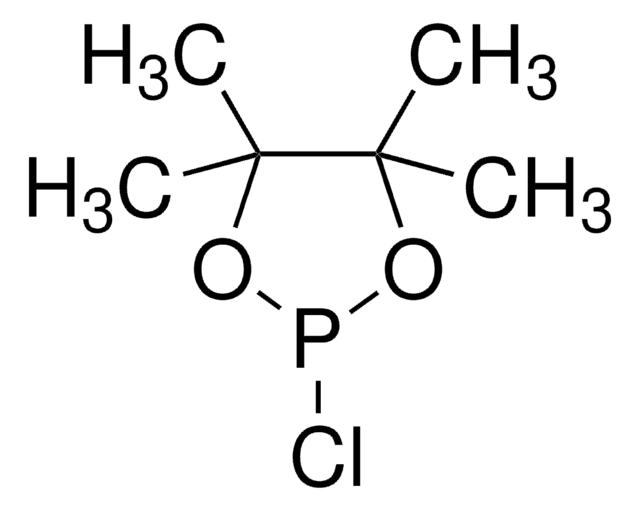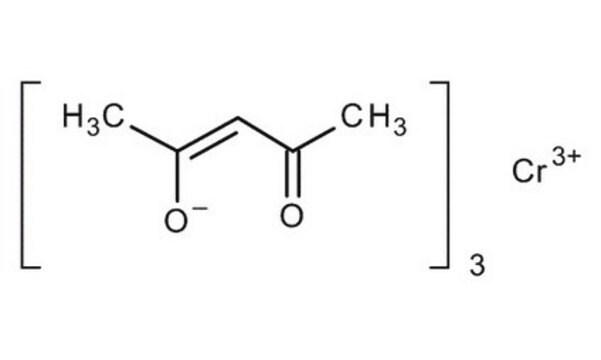202231
Chromium(III) acetylacetonate
97%
Synonym(s):
Chromium(III) 2,4-pentanedionate, Cr(acac)3
Sign Into View Organizational & Contract Pricing
All Photos(3)
About This Item
Linear Formula:
Cr(C5H7O2)3
CAS Number:
Molecular Weight:
349.32
Beilstein:
4148971
EC Number:
MDL number:
UNSPSC Code:
12352103
PubChem Substance ID:
NACRES:
NA.23
Recommended Products
Assay
97%
form
solid
reaction suitability
core: chromium
bp
340 °C (lit.)
mp
210 °C (lit.)
SMILES string
CC(=O)\C=C(\C)O[Cr](O\C(C)=C/C(C)=O)O\C(C)=C/C(C)=O
InChI
1S/3C5H8O2.Cr/c3*1-4(6)3-5(2)7;/h3*3,6H,1-2H3;/q;;;+3/p-3/b3*4-3-;
InChI key
JWORPXLMBPOPPU-LNTINUHCSA-K
Looking for similar products? Visit Product Comparison Guide
Related Categories
Application
- Redox-Activity Catalysis: Discusses the ligand field-activated redox activity of Chromium(III) acetylacetonate, highlighting its use in hydrogenation catalysis (Vinum et al., 2020).
- Diffusion Behavior in Supercritical CO2: A study examining the diffusion behavior of Chromium(III) acetylacetonate in supercritical CO2, aiding in the application of supercritical fluids in materials processing (Cordeiro et al., 2016).
Analysis Note
Used to modify the surface properties of solid polyurethanes formed in its presence.
Signal Word
Warning
Hazard Statements
Precautionary Statements
Hazard Classifications
Eye Irrit. 2 - Skin Irrit. 2
Storage Class Code
11 - Combustible Solids
WGK
WGK 2
Flash Point(F)
>392.0 °F
Flash Point(C)
> 200 °C
Personal Protective Equipment
dust mask type N95 (US), Eyeshields, Gloves
Choose from one of the most recent versions:
Already Own This Product?
Find documentation for the products that you have recently purchased in the Document Library.
Customers Also Viewed
Yi Wang et al.
Journal of medicinal chemistry, 56(23), 9601-9611 (2013-11-28)
Current precious-metal-containing anticancer agents are mostly chelated with N-containing ligands and function by interacting with DNA. In the present study, Pd(acac)2, a Pd(II) complex containing four O-donor ligands, has been evaluated as an active anticancer agent. Pd(acac)2 showed no interaction
Gong-Jun Chen et al.
Dalton transactions (Cambridge, England : 2003), 39(44), 10637-10643 (2010-10-06)
Two Eu(III) complexes, [Eu(acac)(3)(dpq)] (1) and [Eu(acac)(3)(dppz)] CH(3)OH (2) {viz. acetylacetonate (acac), dipyrido[3,2-d:20,30-f]quinoxaline (dpq), dipyrido[3,2-a:20,30-c] phenazine (dppz)}, have been synthesized and their DNA binding, photo-induced DNA cleavage activity and cell cytotoxicity are studied. The complexes display significant binding propensity to
The direct writing of plasmonic gold nanostructures by electron-beam-induced deposition.
Katja Höflich et al.
Advanced materials (Deerfield Beach, Fla.), 23(22-23), 2657-2661 (2011-05-04)
Channa R De Silva et al.
Journal of the American Chemical Society, 131(18), 6336-6337 (2009-04-17)
Nearly monodisperse lanthanide-doped magnetite nanoparticles were obtained by thermally decomposing a mixture of Fe(acac)(3) and Ln(acac)(3) (acac = acetylacetonate; Ln = Sm, Eu, Gd) in the presence of passivating surfactants. Magnetic studies revealed room-temperature ferromagnetic behaviors of these doped nanoparticles
Zhan'ao Tan et al.
Physical chemistry chemical physics : PCCP, 14(42), 14589-14595 (2012-09-28)
A solution-processed vanadium oxide (s-VO(x)) anode buffer layer on an indium-tin-oxide (ITO) electrode was used instead of PEDOT:PSS for improving the stability and photovoltaic performance of the polymer solar cells (PSCs). The s-VO(x) layer was prepared by spin-coating a vanadyl
Our team of scientists has experience in all areas of research including Life Science, Material Science, Chemical Synthesis, Chromatography, Analytical and many others.
Contact Technical Service












